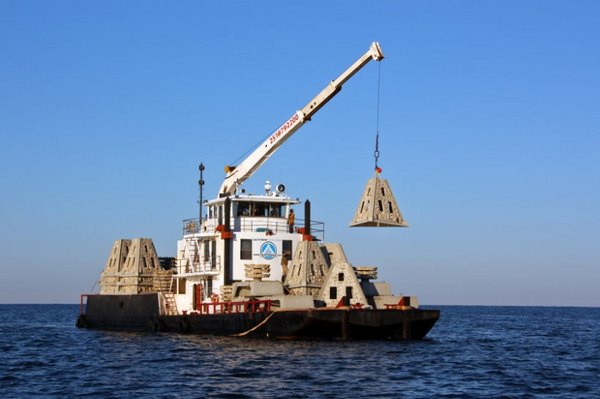April 23, 2013
By Florida Sportsman Newswire
 Photo Courtesty of Mexico Beach Articial Reef Association.
Photo Courtesty of Mexico Beach Articial Reef Association.
From FWC "Goin' Coastal," Press Release
The Mexico Beach Artificial Reef Association, which is one of the most active nonprofit artificial reef organizations in the state, on behalf of the city of Mexico Beach, just completed the oversight and management of a significant expansion to several existing artificial reef sites off Bay County. The old phrase “if you build it, they will come” could not be more applicable, and the cities of Mexico Beach, Port St. Joe, recreational anglers, charter captains and local businesses will be the ultimate beneficiaries.
On April 6, the most recent deployment, 62 individual reef structures, each weighing more than 3,500 pounds, were added at 19 locations. In a grant to the city to support the project, the Florida Fish and Wildlife Conservation Commission (FWC) provided $60,000 in federal aid from Sport Fish Restoration Act funds. That grant was matched by $31,600 from Mexico Beach Artificial Reef Association. The deployment locations are in state and federal waters, 2.3 to 16.8 nautical miles from the Mexico Beach Channel entrance, ranging in depth from 22 feet in the Bell Shoals Area to 101 feet in the North Site Area.
The deployment of several different types of modules included:
? Tetrahedron-shaped reef modules with limestone sides that make it easier for invertebrates to attach.
? Rectangular box-shaped reefs designed to provide habitat for gag grouper.
? Ecosystem reefs shaped like a layer cake with round concrete and rock discs separated by spacers for juvenile fish habitat.
? A newly designed “hybrid reef” that includes a grouper module and an attached ecosystem reef on top.
Fishers have long understood the value of constructing artificial reefs, and over the past 30 to 40 years a great deal has been learned through trial and error.
In the early days, reef materials included just about anything that was heavy enough to sink and often included tires, household appliances, junk cars and many other less-than-ideal materials. The problem with many of the materials that were used historically is that they were not stable, durable or environmentally friendly. Many were not heavy enough to stay in place. Other materials were not structurally sufficient to withstand ocean currents and saltwater corrosion for lengthy periods of time.
While some of these older materials have been ripped apart and scattered around by storms, it is also likely that some of these materials would not meet today's standards that require removal of all oils, greases, paints, solvents or other chemicals that may be potentially harmful to marine organisms.
Today's reefs, including those deployed recently off Mexico Beach, are constructed of concrete, limestone and heavy-gauge steel, all of which will stay in place and provide excellent marine habitat for decades to come.
Similarly, people have also learned a great deal about selecting appropriate sites for artificial reefs. Permits for reef areas issued by the Florida Department of Environmental Protection and the U.S. Army Corps of Engineers to local coastal governments in both state and federal waters require bottom surveys before reef deployment to verify that the areas are free of natural reefs, seagrass habitat, shellfish beds and archaeological resources. This requirement is very important because it prevents artificial reef damage to existing valuable natural habitats.
Taking care to choose the best location also avoids interfering with other uses of the sea floor such as navigational channels, military operational areas, sand borrow areas, traditional shrimp trawling grounds, and underwater pipeline and cable corridors.
Can artificial reefs increase the overall populations of fish over time? I don't think we have an absolute answer on that.
Artificial reefs will never be a replacement for sound fisheries management and regulations to prevent overfishing. They do play an important role as attractive fishing and diving destinations, which means more hotel night stays, more restaurant meals served, and more demand for boats, tackle and fuel. All are great things for a small town like Mexico Beach that relies on visitors who travel to the area to enjoy beautiful beaches and great saltwater fishing.
Please visit the Mexico Beach Artificial Reef Association website at MBARA.org for new reef coordinates, membership information, upcoming events and fishing tournaments.

